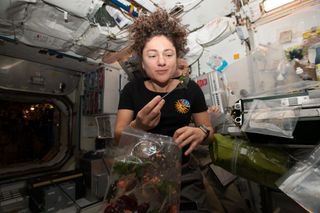
As astronauts harvest and munch on mizuna, or Japanese mustard greens, aboard the International Space Station, the future of humans growing their own food in space grows brighter.
In 2015, astronauts aboard the space station grew a crop of red lettuce — the first food grown in space. But "space food" and the prospect of growing viable crops and plants in space has been in development for some time.
"For many years," NASA plant physiologist Ray Wheeler told Space.com, NASA has "been interested in growing plants as a bioregenerative approach for life support, and the plants would provide food and oxygen and could remove carbon dioxide."
Now, with the new experiment Veg-04B with the Vegetable Production System (Veggie), a plant growth unit on the space station, this capability has taken another big step forward. The experiment is testing how the quality of light and fertilizer affects the microbial safety, nutritional value and taste of a mizuna crop. And this past week (on Nov. 13), astronauts Jessica Meir and Christina Koch completed the second of three harvests of this mildly tangy, leafy vegetable.
As the space station's Twitter account shared on Nov. 18, "A portion of the leaves were consumed by the crew while the rest were stowed in a freezer for later analysis on Earth."
Why grow space plants?
Ultimately, the goal of experiments like Veg-04B is to create reliable and sustainable food production in space. Theoretically, future human settlers on Mars and the moon could grow at least a portion of their diet themselves. This would provide fresh, crunchy produce with optimal nutritional value for astronauts and make it so that they wouldn't have to rely entirely on supply missions from Earth."Over time, that packaged diet … it loses quality and it loses nutrition. Some of the vitamins will degrade," Gioia Massa, principal investigator for Veggie, told Space.com. Additionally, while astronauts on the space station have access to food regularly sent via cargo missions, "astronauts tend to lose weight," Massa added. "We think that this weight loss is due to menu fatigue, and so we postulate that adding fresh produce to the diet could help with that."
By continuing to experiment with new crops in the microgravity environment on the space station, researchers can see how, like with the mizuna, plants retain their nutritional value and taste, and also how they grow. With controlled experiments on Earth, scientists can get a good sense of how new types of plants might grow in space, but they can't know for sure how they will develop over time until they are up on the station.
New crops
Now, while mizuna is a leafy green like the red lettuce first grown in space, Massa explained that they have big plans for upcoming space crops. She said that, while they started with leafy greens, they plan to move on to tomatoes, peppers, nutrient-packed microgreens and more. Wheeler added that eventually they might even grow small fruits like strawberries with dwarf fruit trees.Massa said that they do consult the astronauts about what crops they would like to grow. And, surprisingly, while many have suggested foods like corn, she said, others have suggested flowers. For now, while they develop experiments with new crops, Massa said that they are considering, in the future, sending up a variety of seeds that could be in stock and available to the crew, so that they could select what they want to grow on orbit.
Chelsea Gohd
Source News
No comments:
Post a Comment
Note: Only a member of this blog may post a comment.